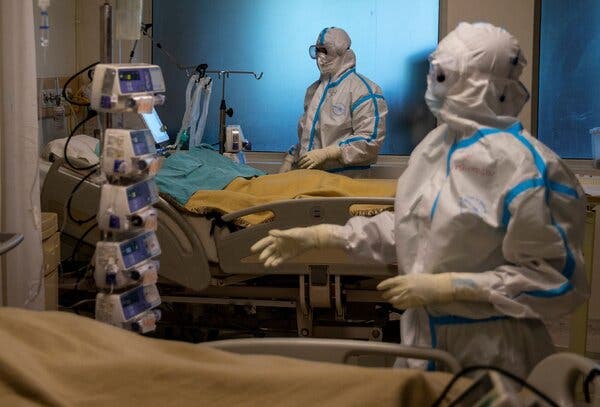Here’s what you need to know:
- Skyrocketing cases push India to No. 2 on the pandemic list.
- On a holiday weekend in the U.S., the virus continues its grinding hold on Americans’ lives.
- Britain is stunned by a spike in daily cases.
- In a year of voting by mail, poll officials scramble to shore up in-person voting, too.
- China reveals its game plan for a post-pandemic world.
Skyrocketing cases push India to No. 2 on the pandemic list.
India, home to the world’s fastest-growing coronavirus outbreak, has surpassed Brazil to become the country with the second-highest number of cases.
On Monday, India reported 90,802 new infections, breaking its own record from the day before and taking its total to more than 4.2 million, according to a New York Times database. Brazil is now third with more than 4.1 million cases.
In early July, India surpassed Russia to become the country with the third-highest number of cases. By then, the United States was entrenched at No. 1, where it remains today with more than 6.2 million cases.
“Crowded cities, lockdown fatigue and a lack of contact tracing have spread Covid-19 to every corner of this country of 1.3 billion people,” The Times’s Jeffrey Gettleman and Sameer Yasir reported in late August.
India has recorded 71,642 deaths from the virus, the world’s third-highest toll after the United States and Brazil, though as a youthful nation India has a relatively low death rate per capita.
India’s surge in cases comes as the government continues to ease lockdown measures in an effort to help the economy. On Monday, the subway system in New Delhi, the capital, began a phased reopening after being shut for more than five months.
The pandemic has been economically devastating for India, which not so long ago dreamed of becoming a global powerhouse. Last week, the government reported a 24 percent contraction in the second quarter, the worst among the world’s top economies.
On a holiday weekend in the U.S., the virus continues its grinding hold on Americans’ lives.
Before Memorial Day weekend in May, the United States recorded a seven-day average number of new cases of 22,580, according to a New York Times database, and the average for new deaths announced was 1,216.
At the beginning of Labor Day weekend on Friday, the seven-day average number of new cases was 41,233, and the average number of new deaths reported was 851.
Within those numbers are more complicated stories:
In May, the country was beginning to emerge from lockdown. The number of overall deaths in the U.S. was nearing 100,000. And doctors were trying to find answers to a mysterious virus-related ailment affecting children. The death toll in New York, once the epicenter of the virus outbreak, had dropped below 100 for the first time since March.
Most parents and children are in the early stages of another round of online learning. Many colleges and universities have welcomed students back. The country is mostly open. And New York, once the hottest of hot spots, announced that the positivity rate for the state had remained under 1 percent for the past month. Still, cases in the Midwest are spiking. And the reopening of college campuses has spurred outbreaks. More than 51,000 cases have been reported at more than 1,000 campuses. Some students have faced serious consequences for breaking the rules. Northeastern University in Massachusetts dismissed 11 students last week for violating safety precautions. New York University, Ohio State, West Virginia University and Purdue have all suspended students over violations of rules intended to curb the virus’s spread on campus.
And higher education institutions are dealing with more challenges. A student group at the University of Kansas, where there are nearly 500 cases, is planning a “strike” to push the university to move to remote learning, The Kansas City Star reported; this follows a similar “sickout” last week at the University of Iowa.
global roundup
Britain is stunned by a spike in daily cases.
British health officials on Sunday announced a sharp rise in new infections, prompting warnings that they may need to reconsider the aggressive reopening of the country.
The British Public Health agency reported that 2,998 new cases had been confirmed — the highest number since late May, during the British outbreak’s peak.
Amid criticism that the government had once again lost control of an outbreak that has already killed at least 41,000 people in Britain, government officials signaled that they were prepared to crack down.
“We’ll take whatever action is necessary,” said Matt Hancock, the health secretary, declaring that “we can use, and we will use, local lockdowns if that’s what’s necessary.”
But noting that, as is the case in many parts of the world, the newest outbreak is hitting mostly younger people, Mr. Hancock implored them to think of their grandparents and be vigilant.
“The first line of defense is that people should follow social distancing,” he said.
There have been almost 350,000 coronavirus cases in Britain, which was initially reluctant to acknowledge the threat posed by the outbreak and act decisively to shut down. It suffered some of the worst losses in Europe in April and May, but gradually cases began to decline after the government moved to lock down.
In August, however, cases began rising again.
With schools newly reopened, some British experts are sounding the alarm over the newest infection numbers.
“They’ve lost control of the virus,” Gabriel Scally, a former National Health Service official told The Guardian.
In other developments around the world:
-
Australia on Monday announced deals to buy almost 85 million doses of two promising coronavirus vaccines if their trials prove successful. The vaccines, both of which are likely to require two doses per person, would be provided free to Australia’s 25 million people at a cost of $1.2 billion. One of the vaccines, produced by the University of Oxford and the British-Swedish drug maker AstraZeneca, is in the final stage of testing and could be available starting in January. The other one, produced by the University of Queensland and the Australian biotechnology company CSL, would follow in mid-2021. Australia has said it is aiming for a 95 percent vaccination rate but will not make them compulsory.
In a year of voting by mail, poll officials scramble to shore up in-person voting, too.
Unnerved by the difficulties of voting amid a pandemic and faced with both the political static injected by President Trump and the limits on expanding voting by mail, state and local authorities across the country are racing to rethink and reinforce the polling sites where tens of millions of people are still expected to cast their ballots.
For all of the attention on voting by mail, perhaps four in 10 votes — 60 million ballots — are likely to be cast in person this fall, either early or on Election Day. Overall turnout could well reach 150 million for the first time, up from 137.5 million in 2016, according to Barry C. Burden, the director of the Elections Research Center at the University of Wisconsin-Madison.
Against the backdrop of Mr. Trump’s relentless criticism of voting by mail, the breakdowns at the Postal Service and the relatively high rate of rejections of mailed-in ballots, election officials and activists in both parties are amping up efforts to hire and train poll workers; integrate stadiums, arenas and malls into their voting options; and come up with contingency plans if there’s a surge in coronavirus cases in the fall.
A major area of concern is finding younger people who are able to replace older ones most susceptible to the ravages of Covid-19 at a time when 58 percent of the nation’s poll workers are 61 or older.
“Everyone’s focusing on the rate of voting by mail, which is going to easily double what it was in 2016 — somewhere north of 80 million ballots,” said Paul Gronke, an expert on in-person voting at Reed College in Portland, Ore. “But people aren’t paying attention to what might happen if there’s a spike in the pandemic or a shortage of poll workers and there’s a last-minute reduction in in-person voting.”
China reveals its game plan for a post-pandemic world.
China’s leader, Xi Jinping, has used his recent trips to highlight a warning: The country must retool its economy to be more self-sustaining in a post-pandemic world of uncertainty, weakened demand and hostility.
Mr. Xi’s recent itinerary reflects the broader strategy he is mapping for China while the United States and other Western powers remain largely consumed with the coronavirus crisis.
China needs its people to spend more and its manufacturers to be more innovative, Mr. Xi has said, to ease dependence on fickle foreign economies. Most pressing, official media comments on Mr. Xi’s strategy have said, China must be ready for sustained acrimony with the United States that could put at risk its access to American consumers, investors and technology.
Though China’s exports have rebounded from the shock of the first months of the pandemic — the government reported on Monday that exports surged 9.5 percent in August from a year earlier, even better than expected — Mr. Xi has suggested that the longer-term outlook is uncertain.
“The world has entered a period of turbulence and transformation,” he told an audience of prominent Chinese economists brought to the Communist Party’s headquarters in central Beijing late last month. “We face an external environment with even more headwinds and countercurrents.”
Mr. Xi has called his new initiative a “dual circulation” strategy. The grandly technocratic name, which he first used in May, means China should rely on a robust cycle of domestic demand and innovation as the main driver of the economy while maintaining foreign markets and investors as a second engine of growth.
The initiative comes as Trump administration officials have tried taking a political sledgehammer to China over the coronavirus pandemic, asserting that the Chinese Communist Party covered up the initial outbreak and allowed the virus to spread around the globe. A recent U.S. intelligence report says top officials in Beijing were in the dark in early January on the true dangers of the virus, a revelation that could affect U.S. policy on China.
Reporting was contributed by Livia Albeck-Ripka, Keith Bradsher, Chris Buckley, Kenneth Chang, Nick Corasaniti, Natasha Frost, Ethan Hauser, Cindy Lamothe, Christina Morales, Bryan Pietsch, Mike Seely, Neil Vigdor and Michael Wines.





















